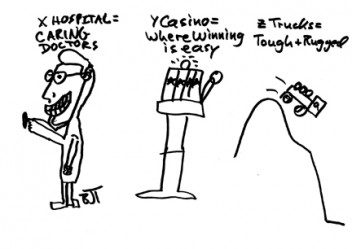
Brands struggle to avoid category platitudes.
Don’t settle for a category benefit when you define your brand strategy. One of the biggest problems we see when a team tries to craft a new brand strategy is that they focus on highly important issues in the category — but those issues are simply category table stakes. Category benefits or category table stakes are the attributes or benefits that a brand needs to offer just to be in the business at all. They can also be important benefits that every brand in the category speaks to already. Category benefits may be important but they don’t differentiate your brand. They just put you in the game.
We like to use the example of snowboards. We had the opportunity a while back to advise a large player in the category about how to better position their brand. The first thing we noticed was that every brand in the category had done research or intuited that the ultimate moment in snowboarding is the adrenaline rush when you catch some air. As a consequence, every single brand had ads running that featured snowboarders flying through the air. There is no doubt that this adrenaline rush moment is important in the category, but if your brand is all about that moment, it is still not differentiated. We pushed them on what their point of view was on that category benefit. How do they see it differently? How do they deliver it differently or better? Or, is there another equally important snowboarding moment that hasn’t become table stakes yet — a moment we could own?
We often see internal client teams become particularly smitten with category benefits when trying to define a positioning for their brands. A rental car operator that offers “safe, new cars” is probably speaking to a category benefit. Who doesn’t have safe, new cars among the big players? A financial services company that offers “trustworthy, informed advice” is also simply touting a category benefit. Is there a financial services company that touts its “lying, cheating advisers?”
Here’s a good test. If you have a brand position you think is good, ask yourself if there is a valid opposing position in the market. If there isn’t, then you probably just have a category benefit and not a differentiating idea. Using the example of BMW, you could say that there is a valid opposing point of view from a “performance sedan.” It could be “supreme luxury.” It could be “precision engineering.”
The truck category is full of category benefits right now. Every truck is “tough, rugged and durable.” Important attributes in a truck — but only category table stakes. There is no “frilly, fragile truck” brand. The US trucks always have a dose of cliche masculinity and toughness. It’s obviously important, but it’s not a differentiator. The Nissan Frontier ads right now look a lot like the Toyota Tacoma ads from recent years. Yes, the Japanese trucks need to address a perceived short-coming here, but they also need to differentiate.


I think if more brands applied context to define who their users were they would have have a better chance at developing strategies that differentiated. Sure trucks are tough and durable. They are supposed to be. But what happens when it in the context of the women are the ones that are driving them. Then they become trucks for tough durable women that don’t want to be treated like they don’t know what they are doing. Like me when I was hauling horses. (I had a Tacoma. Let’s talk about torque.)
Same goes for snow boards. Yeah on a good snowboard you catch air. Your supposed to. But what about when it’s in the context of kids dealing with skyrocketing lift costs, expensive snowboarder wear, and harder-to-score kid job income? If your my nephew, it’s the one of the few things worth bagging Call of Duty money for.
BTW wish me luck. Im going snowboarding for the first time this week end. We may have a new context to talk about….
Good point Valerie. I’m going to talk about innovative targeting as a way to find new, fertile ground for brand strategy in an upcoming post. Thanks for your feedback!
-Bruce